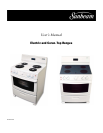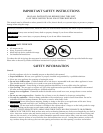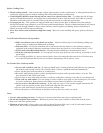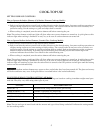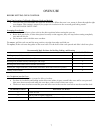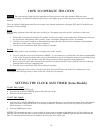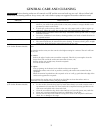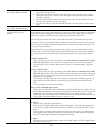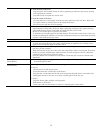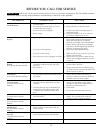
12
BEFORE YOU CALL FOR SERVICE
IMPORTANT Before you call for service, review this list. It may save you time and expense. The list includes common
occurrences that are not the result of defective workmanship or materials in this appliance.
OCCURRENCE
POSSIBLE CAUSE
SOLUTION
1) Surface Elements Or Oven
Not Will Operate
a) Make sure cord plug is plugged tightly into
grounded outlet.
b) A household fuse been blown or has the
circuit breaker been tripped.
c) Service wiring is not complete.
d) Power outage.
a) Check it.
b) Replace the fuse or reset the circuit.
c) Contact your dealer, installing agent or
authorized service.
d) Check house lights to be sure. Call your
local electric company for service.
2) Surface Elements Do Not Heat
Properly
a) Lightweight or warped pans used.
b) No power to the appliance.
c) Incorrect control setting.
d) The surface units are not plugged in solidly.
a) Use only flat, evenly balanced, medium or
heavyweight cookware. Flat pans heat
better than warped pans. Cookware
materials and weight of the material affect
heating. Heavy and medium-weight pans
heat evenly. Because lightweight pans heat
unevenly, foods may burn easily.
b) Check steps under Occurrence (1)
c) Make sure the correct control is on for the
surface unit to be used.
d) With controls off, check to make sure the
surface unit in plugged completely into the
receptacle.
3) Drip Bowls Are Pitting Or
Rusting
(Coil Surface Elements Models)
a) Foods with acids, such as tomatoes, if
allowed to stand in/on bowls will cause
corrosion.
b) Environment.
a) Remove and wash drip bowls as soon as
possible after a spillover.
b) Houses along seacoast are exposed to salt
air. Protect bowls as much as possible from
direct exposure to salt air.
4) Drip Bowls Are Turning Color
Or Distorted
(Coil Surface Elements Models)
a) Bottom surface of cookware extends
beyond surface elements and touches cook-
top surface
a) This can cause high enough temperatures to
discolor the drip bowls. DO NOT use
cookware of this type. Pan sizes should be
matched to the size of the element.
5) Scratches Or Abrasions On
Cook-top Surface
(Ceramic Glass Cook-top
Models)
a) Coarse particles such as salt or sand
between cook-top and utensils can cause
scratches.
b) Cleaning materials not recommended for
ceramic glass cook-top have been used.
c) Cookware with rough bottom has been
used.
a) Be sure cook-top surface and bottoms of
utensils are clean before usage. Small
scratches do not affect cooking and will
become less visible with time.
b) Check them.
c) Use smooth, flat-bottomed cookware.
6) Metal Marks
(Ceramic Glass Cook-top
Models)
a) Sliding or scraping of metal utensils on
cook-top surface
a) Do not slide metal utensils on cook-top
surface. Use a ceramic glass cook-top
cleaning cream to remove the marks.
7) Brown Streaks Or Specks
(Ceramic Glass Cook-top
Models)
a) Boil-overs are cooked onto surface a) Use a razor blade scraper to remove soil.
8) Areas Of Discolorations With
Metallic Sheen
(Ceramic Glass Cook-top
Models)
a) Mineral deposits from water and food.
Remove using a ceramic glass cook-top
cleaning cream
a) Use cookware with clean, dry bottoms.
9) Hot Surface Indicator Light
Stays On
(Ceramic Glass Cook-top
Models)
a) The hot surface indicator light stay on after
control knob(s) have been turned OFF.
a) Check it.



